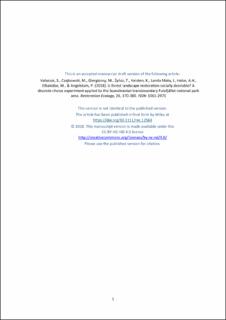| dc.contributor.author | Valasiuk, Sviataslau | |
| dc.contributor.author | Czajkowski, Mikołaj | |
| dc.contributor.author | Giergiczny, Marek | |
| dc.contributor.author | Zylicz, Tomasz | |
| dc.contributor.author | Veisten, Knut | |
| dc.contributor.author | Landa-Mata, Iratxe | |
| dc.contributor.author | Halse, Askill Harkjerr | |
| dc.contributor.author | Elbakidze, Marine | |
| dc.contributor.author | Angelstam, Per | |
| dc.coverage.spatial | Europe | en_US |
| dc.date.accessioned | 2021-07-18T14:36:27Z | |
| dc.date.available | 2021-07-18T14:36:27Z | |
| dc.date.created | 2018-01-03T11:11:12Z | |
| dc.date.issued | 2017 | |
| dc.identifier.citation | Restoration Ecology. 2017, 26 (2), 370-380. | en_US |
| dc.identifier.issn | 1061-2971 | |
| dc.identifier.uri | https://hdl.handle.net/11250/2764729 | |
| dc.description.abstract | Using an economic valuation approach, we assessed people's stated preferences for policy aimed at enhancing restoration of functional networks of naturally dynamic boreal forest habitats as a public good. Active landscape restoration can improve the functionality of boreal forest habitats as green infrastructure, which is essential for biodiversity conservation and delivery of multiple ecosystem services that production forests are poor at providing. In contrast, so far designation of protected areas in Fennoscandia has focused on remnant patches of near‐natural forests, and not on forest landscape restoration. We assessed citizens' preferences for forest landscape restoration in a transboundary region primarily managed for sustained‐yield wood production for the forest industry, and which hosts the transboundary Fulufjället National Parks in Sweden and Norway. We conducted a discrete choice experiment by asking Swedish and Norwegian citizens to choose among two options for the Fulufjället area, including (1) extension of passive protection on one side or both sides of the border, by additional area protection and restoration of forest naturalness, and (2) a status quo option. The scenario assumed that extension of the protected forest area would imply a compulsory tax administered bilaterally by the two countries. Just over half of the sample, in both countries expressed willingness to pay for forest landscape restoration. Alternatives that contemplated larger extensions of forest landscape restoration were assigned higher willingness‐to‐pay. Public awareness and support, combined with spatial planning, are necessary for forest landscape restoration to become a viable tool for biodiversity conservation in Scandinavia. | en_US |
| dc.language.iso | eng | en_US |
| dc.publisher | Wiley | en_US |
| dc.rights | Attribution-NonCommercial-NoDerivatives 4.0 Internasjonal | * |
| dc.rights.uri | http://creativecommons.org/licenses/by-nc-nd/4.0/deed.no | * |
| dc.title | Is forest landscape restoration socially desirable? A discrete choice experiment applied to the Scandinavian transboundary Fulufjället national park area | en_US |
| dc.type | Peer reviewed | en_US |
| dc.type | Journal article | en_US |
| dc.rights.holder | Copyright © 2018 John Wiley & Sons, Inc. All rights reserved | en_US |
| dc.description.version | acceptedVersion | en_US |
| cristin.ispublished | true | |
| cristin.fulltext | postprint | |
| cristin.qualitycode | 1 | |
| dc.identifier.doi | 10.1111/rec.12563 | |
| dc.identifier.cristin | 1534548 | |
| dc.source.journal | Restoration Ecology | en_US |
| dc.source.volume | 26 | en_US |
| dc.source.issue | 2 | en_US |
| dc.source.pagenumber | 370-380 | en_US |

